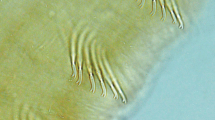Abstract
The rediscovery of Halocardyle fragilis Vannucci, of which the type material is lost, led us to consider it a variety of Halocardyle disticha (Goldfuss) that occurs in calm waters on soft bottoms. The typical H. disticha is open feather-shaped, with branching in one plane, while H. fragilis is bushy, much larger, with branching in many planes. The different habit of H. disticha is probably due to environmental conditions. The bushy and pinnate forms are considered extremes of a range of morphological variation.
Similar content being viewed by others
References
Bandel, K. & E. Wedler, 1987. Hydroid, amphineuran and gastropod zonation in the littoral of the Caribbean Sea, Colombia. Senckenberg. marit. 19: 1–129.
Bouillon, J., 1985. Essai de classification des hydropolypeshydroméduses (Hydrozoa-Cnidaria). Indo-Malayan Zool. 2: 29–243.
Brinckmann-Voss, A., 1970. Anthomedusae/Athecata (Hydrozoa, Cnidaria) of the Mediterranean. Part 1. Capitata. Fauna Flora Golfo Napoli 39: 1–96.
Calder, D. R., 1971. Hydroids and hydromedusae of southern Chesapeake Bay. Spec. Pap. mar. Sci., Va Inst. mar. Sci. 1: 1–125.
Calder, D. R., 1988. Shallow-water hydroids of Bermuda: the Athecatae. Contr. Life Sci. Div. R. Ont. Mus. 148: 1–107.
Garcia-Corrales, P. & A. Aguirre, 1985. La especie Halocordyle disticha (Goldfuss, 1820), y sus sinonimias. Boln Inst. esp. Oceanogr. 2: 85–96.
Goldfuss, G. A., 1820. Handbuch der Zoologie. I Abteilung. Johann Leonhard Schrag, Nürnberg,696 pp.
Hirohito, 1977. Five hydroid species from the Gulf of Aqaba, Red Sea. Pubis biol. Lab., Imp. Household, Tokyo. (1977) (11): 1–26.
Hughes, R. G., 1980. Current induced variations in the growth and morphology of hydroids. In P. Tardent & R. Tardent (eds), Developmental and Cellular Biology of Coelenterates. Elsevier/North Holland Biomedical Press, Amsterdam: 179–184.
Mergner, H., 1977. Hydroids as indicator species for ecological parameters in Caribbean and Red Sea coral reefs. Proc. 3rd int. Coral Reef Symp. 1: 119–125.
Mergner, H., 1987. Hydroids as indicator species of environmental factors on coral reefs. In J. Bouilon, F. Boero, F. Cicogna & P. F. S. Cornelius (eds), Modern Trends in the Systematics, Ecology, and Evolution of Hydroids and Hydromedusae. Oxford Univ. Press, Oxford: 185–195.
Migotto, A. E. & F. L. da Silveira, 1987. Hidróides (Cnidaria, Hydrozoa) do litoral sudeste e sul do Brasil: Halocordylidae, Tubulariidae e Corymorphidae. Iheringia (Ser. Zool.) 66: 95–115.
Millard, N. A. H., 1975. Monograph on the Hydroida of southern Africa. Ann. S. Afr. Mus. 68: 1–513.
Östman, C., S. Piraino & W. Kem, 1991. Nematocysts of the Mediterranean hydroid Halocordyle disticha. Hydrobiologia 216/217: 607–613.
Vannucci, M., 1950. Resultados cientificos do Cruzeiro do ‘Baependi’ e do ‘Vega’ a Ilha da Trindade. Hydrozoa. Bolm Inst. oceanogr. S. Paulo 1: 81–96.
Vannucci, M., 1951. Hydrozoa e Scyphozoa exsistentes no Instituto Paulista de Oceanografia. I. Bolm Inst. oceanogr. S. Paulo 2: 95–150.
Vannucci, M., 1954. Hydrozoa e Scyphozoa existentes no Instituto Oceanográfico. II. Bolm Inst. oceanogr. S. Paulo 5: 95–149.
Vervoort, W., 1959. The Hydroida of the tropical west coast of Africa. Atlantide Rep. 5: 211–325.
Wainwright, S. A., W. D. Biggs, J. D. Currey & J. M. Gosline, 1976. Mechanical design in organisms. Edward Arnold, London, 423 pp.
Wedler, E., 1975. Ökologische Untersuchungen an Hydroiden des Felslitorals von Santa Marta (Kolumbien). Helgoländer wiss. Meeresunters. 27: 324–363.
Wedler, E. & R. Larson, 1986. Athecate hydroids from Puerto Rico and the Virgin Islands. Stud. neotrop. Fauna Envir. 21: 69–101.
Weill, R., 1937. Contribution à l'étude des Pteronemida (Hydrozoaires). Le Cnidome de Cladocoryne floccosa Rotsch et son interprétation (d'après les documents laissés par feu Maurice Philbert). Bull. Inst. océanogr. Monaco 719: 1–11.
Author information
Authors and Affiliations
Rights and permissions
About this article
Cite this article
da Silveira, F.L., Migotto, A.E. The variation of Halocordyle disticha (Cnidaria, Athecata) from the Brazilian coast: an environmental indicator species?. Hydrobiologia 216, 437–442 (1991). https://doi.org/10.1007/BF00026497
Issue Date:
DOI: https://doi.org/10.1007/BF00026497




